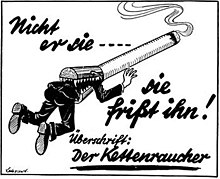
In the early 20th century, German researchers found additional evidence linking smoking to health harms,[2][3][1] which strengthened the anti-tobacco movement in the Weimar Republic[4] and led to a state-supported anti-smoking campaign.[5] Early anti-tobacco movements grew in many nations from the middle of the 19th century.[6][7] The 1933–1945 anti-tobacco campaigns in Nazi Germany have been widely publicized,[8][9][10] although stronger laws than those passed in Germany were passed in some American states, the UK, and elsewhere between 1890 and 1930.[11][12] After 1941, anti-tobacco campaigns were restricted by the Nazi government.[9]
The German movement was the most powerful anti-smoking movement in the world during the 1930s and early 1940s.[1] However, tobacco control policy was incoherent and ineffective, with uncoordinated and often regional efforts by many actors. Obvious measures were not taken, and existing measures were not enforced.[9] Some[9] Nazi leaders condemned smoking[13] and several of them openly criticized tobacco consumption,[1] but others publicly smoked and denied that it was harmful.[9]
There was much research on smoking and its effects on health during Nazi rule,[14] and it was the most important of its type at that time.[15] A directly supported tobacco research institute produced work of only marginal scientific importance,[16] but substantial academic work was done privately, with little to negative official support.[3][9]
Adolf Hitler's personal distaste for tobacco[17] and the Nazi reproductive policies were among the motivating factors behind the Nazi campaigns against smoking.[18] The Nazi anti-tobacco campaign included banning smoking in trams, buses, and city trains,[1] promoting health education,[19] limiting cigarette rations in the Wehrmacht, organizing medical lectures for soldiers, and raising the tobacco tax.[1] The Nazis also imposed restrictions on tobacco advertising and smoking in public spaces, and regulated restaurants and coffeehouses.[1] However, these measures were widely circumvented or ignored.[9]
The movement did not reduce the number of smokers. Tobacco use increased rapidly in the early years of the Nazi regime, between 1933 and 1939.[20] The number of smokers increased from 1939 to 1945, but cigarette consumption declined;[9] rationing towards the end of the war[9] and post-war poverty[1] meant that the increasing numbers of smokers could not buy as many cigarettes.[9] Nazi-related nicotine marketing messages have often been used to oppose tobacco control, and criticized for historical inaccuracy.[10][9] Even by the end of the 20th century, the anti-smoking movement in Germany had not attained the influence of the Nazi anti-smoking campaign. Germany has some of the weakest tobacco control measures in Europe, and German tobacco research has been described as "muted".[20]
- ^ a b c d e f g h Proctor RN (December 1996). "The anti-tobacco campaign of the Nazis: a little known aspect of public health in Germany, 1933–45". British Medical Journal. 313 (7070): 1450–1453. doi:10.1136/bmj.313.7070.1450. PMC 2352989. PMID 8973234.
- ^ Proctor RN (2012). "The history of the discovery of the cigarette-lung cancer link: evidentiary traditions, corporate denial, global toll". Tobacco Control. 21 (2): 87–91. doi:10.1136/tobaccocontrol-2011-050338. PMID 22345227.
- ^ a b Cite error: The named reference
Lickintwas invoked but never defined (see the help page). - ^ Young 2005, p. 252
- ^ Szollosi-Janze 2001, p. 15
- ^ Doll R (June 1998). "Uncovering the effects of smoking: historical perspective" (PDF). Statistical Methods in Medical Research. 7 (2): 87–117. doi:10.1177/096228029800700202. PMID 9654637. S2CID 154707. Archived from the original (PDF) on 1 October 2018. Retrieved 1 June 2008.
Societies were formed to discourage smoking at the beginning of the century in several countries, but they had little success except in Germany where they were officially supported by the government after the Nazis seized power.
- ^ Borio G (1993–2003). "Tobacco Timeline: The Twentieth Century 1900-1949—The Rise of the Cigarette". Tobacco News. Archived from the original on 17 October 2008. Retrieved 15 November 2008.
- ^ Cite error: The named reference
about_lickintwas invoked but never defined (see the help page). - ^ a b c d e f g h i j k Cite error: The named reference
notsimplewas invoked but never defined (see the help page). - ^ a b Cite error: The named reference
nazi_rhetoricwas invoked but never defined (see the help page). - ^ Fifteen states prohibited the sale or use of cigarettes at various times between 1890 and 1930 as a result of the activities of the Anti-Cigarette League of America. Alston L, Dupré R, Nonnenmacher T (2002). "Social reformer and regulation: The prohibition of cigarettes in the United States and Canada" (PDF). Explorations in Economic History. 39 (4): 425–445. doi:10.1016/S0014-4983(02)00005-0. Archived from the original (PDF) on 12 August 2017. Retrieved 4 September 2017.
- ^ Cite error: The named reference
dolls_historywas invoked but never defined (see the help page). - ^ Bynum et al. 2006, p. 375
- ^ Proctor RN (1996). "Nazi Medicine and Public Health Policy". Dimensions. Anti-Defamation League. Archived from the original on 31 May 2008. Retrieved 1 June 2008.
- ^ Clark, Briggs & Cooke 2005, pp. 1373–74
- ^ Cite error: The named reference
Jena_foundingwas invoked but never defined (see the help page). - ^ Proctor 1999, p. 219
- ^ Smith GD (December 2004). "Lifestyle, health, and health promotion in Nazi Germany". British Medical Journal. 329 (7480): 1424–25. doi:10.1136/bmj.329.7480.1424. PMC 535959. PMID 15604167.
- ^ Gilman & Zhou 2004, p. 328
- ^ a b Proctor 1999, p. 228